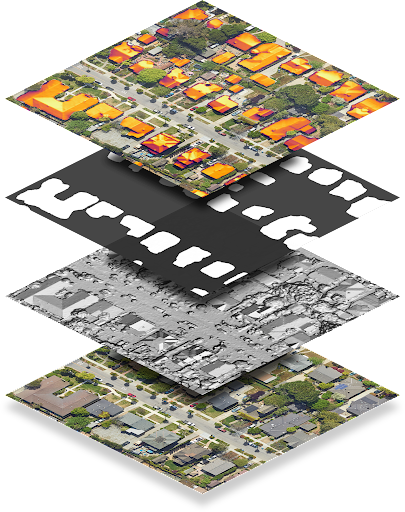
נקודת הקצה dataLayers מחזירה נתונים שמקודדים כקובצי GeoTIFF, שאפשר להשתמש בהם בכל אפליקציית מערכת מידע גיאוגרפי (GIS) כדי לתכנן מערכות סולאריות.
כל מחרוזת בתגובה של dataLayers מכילה כתובת URL, שאפשר להשתמש בה כדי לאחזר את קובץ ה-GeoTIFF המתאים. כתובות ה-URL תקפות למשך שעה לכל היותר אחרי שהן נוצרות מהבקשה המקורית של שכבות הנתונים. אפשר לאחסן קובצי GeoTIFF למשך 30 ימים לכל היותר.
חוץ משכבת ה-RGB, קובצי GeoTIFF לא מוצגים בצורה תקינה בצפייה בתמונות, כי התוכן הוא נתונים מוצפנים ולא תמונות RGB. בנוסף, אי אפשר להשתמש ישירות בקובצי GeoTIFF כתמונת שכבת-על עם Maps Javascript API.
בטבלה הבאה מתואר כל אחד מהשכבות בפירוט.
| שכבה | עומק הפיקסלים | רזולוציה | תיאור |
|---|---|---|---|
| מודל פני שטח דיגיטלי (DSM) | מספר ממשי (float) ב-32 ביט | 0.1 מ' לכל פיקסל | נתוני גובה שמייצגים את הטופוגרפיה של פני השטח של כדור הארץ, כולל מאפיינים טבעיים ומאפיינים מעשה ידי אדם. הערכים הם במטרים מעל פני הים. מיקומים לא תקינים או אזורים שאין לנו נתונים לגביהם מאוחסנים כ-9999-. |
| RGB | 8 סיביות | 0.1 מ'/פיקסל 0.25 מ'/פיקסל |
תמונה אווירית או צילום לוויין של האזור. קובץ התמונות בפורמט GeoTIFF מכיל שלושה פסי תדרים שמתאימים לערכים אדום, ירוק וכחול, כדי ליצור ערך RGB של 24 ביט לכל פיקסל. כברירת מחדל, רזולוציית הפיקסלים היא 0.1 מ' לפיקסל. |
| מסכת בניין | 1-bit | 0.1 מ' לכל פיקסל | ביט אחד לכל פיקסל שמציין אם הפיקסל נחשב לחלק מגג. |
| שטף שנתי | מספר ממשי (float) ב-32 ביט | 0.1 מ' לכל פיקסל | מפת השטף השנתי, או מפת אור השמש השנתי על הגגות באזור.
הערכים הם קוט"ש/קילוואט/שנה. שטף הקרינה מחושב לכל מיקום, ולא רק לגגות של בניינים. מיקומים לא חוקיים או אזורים שלא הצלחנו לחשב בהם את השטף מאוחסנים כ-9999-. מיקומים שנמצאים מחוץ לאזור הכיסוי שלנו לא תקינים. הערה: זהו שטף לא מוסתר. |
| שינוי חודשי | מספר ממשי (float) ב-32 ביט | 0.5 מ' לפיקסל | מפת שטף חודשית (אור שמש על גגות, עם פירוט לפי חודש) של האזור. הערכים הם קוט"ש/קילוואט/שנה. קובץ התמונות GeoTIFF מכיל 12 פסים שתואמים לחודשים ינואר עד דצמבר, לפי הסדר. |
| הצללה לפי שעה | מספר שלם (integer) ב-32 ביט | 1 מ'/פיקסל | 12 כתובות URL של מפות הצללה לפי שעה, בהתאמה לחודשים ינואר עד דצמבר. כל קובץ GeoTIFF מכיל 24 פסים, שמתאימים ל-24 השעות של היום. כל פיקסל הוא מספר שלם בן 32 ביט, שמתאים ל-31 הימים של אותו חודש (לכל היותר). 1 ביט מציין שהמיקום התואם יכול לראות את השמש באותו יום, באותה שעה ובאותו חודש. מיקומים לא חוקיים מאוחסנים כ-9999- והביט 31 מוגדר, כי הוא תואם ליום ה-32 בחודש ולכן הוא לא חוקי. |
פענוח של רשתות צל שעתיות
נתוני הצללה לפי שעה מקודדים ברסטרים מרובי פס. מידע נוסף על יסודות הרסטר זמין במאמר מושגים ב-Solar API.
כשמבקשים נתוני הצללה לפי שעה, אפשר לקבל עד 12 רסטרים, אחד לכל חודש בשנה הקלנדרית (ינואר עד דצמבר). כל רסטר מורכב מ-24 שכבות, או פסים, שמתאימות ל-24 השעות של היום.
כל פס מיוצג על ידי מטריצה של תאים, או פיקסלים. לכל פיקסל יש עומק של 32 ביט, שמתאים ל-31 הימים (המקסימליים) של החודש. לכן, כדי לפענח את היום, השעה והחודש של נתוני הצללה, צריך להבין את הביט, הפס והרסטר שמנתחים.
לדוגמה, כדי לזהות אם מיקום נתון בקואורדינטות (x, y) נחשף לשמש בשעה 16:00 ב-22 ביוני, מבצעים את הפעולות הבאות:
- שולחים בקשה לשכבות נתונים עבור כל השכבות במיקום (x, y).
- כי חודש יוני הוא החודש השישי בשנה, ולכן הפונקציה מאחזרת את כתובת ה-URL השישית ברשימה
hourlyShadeUrls. - הטווחים השעתיים מוצגים בפורמט של 24 שעות. כדי לקבל נתונים לשעה 16:00, צריך לחפש את הערוץ ה-17.
- אינדקס של ביטים (ימים) שמתחיל מ-0. כדי לקבל נתונים ליום ה-22 ביוני, קוראים את הביט 21.
- הביטים מספקים נתונים בינאריים שמציינים אם היה אור שמש במיקום הזה בתאריך ובשעה שצוינו. אם הביט הוא 1, המשמעות היא שהמיקום נחשף לשמש. אם הביט הוא 0, המיקום היה מוצל.
הקוד הבא מסכם את השלבים שלמעלה:
(hourly_shade[month - 1])(x, y)[hour] & (1 << (day - 1))

